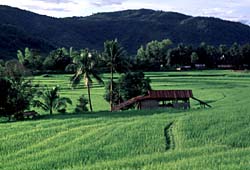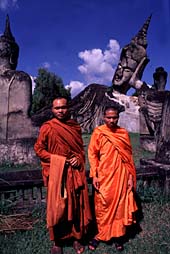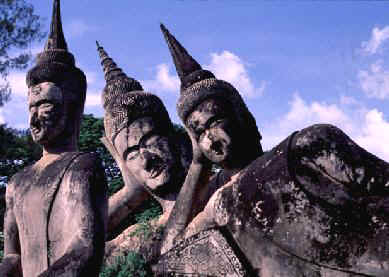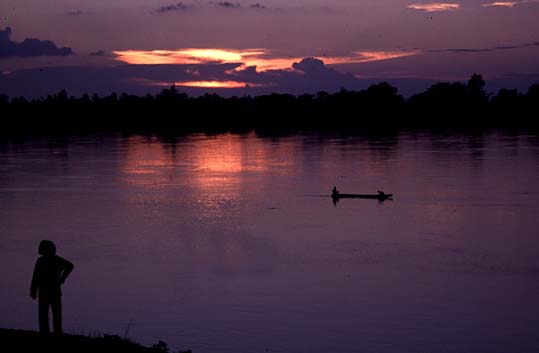LAND IN SLOW MOTION
After years of seclusion and stagnation, the pace of change in Laos has speeded all the way up to a crawl, but fears of foreign influence continue to slow the flow of investment and development in this breathtakingly beautiful backwater
by Ron Gluckman/Laos
K
EEPING A CLOSE EYE on the mobsters, I slink lower in my chair, trying to slurp my noodles inconspicuously -- to little avail. The sole foreigner in a restaurant in the northern town of Luang Namtha, I'm soon spotted. The biggest thug rises, points in my direction, then barks orders at the waitress. Disregarding my protests, she pulls me over to meet the gang.I approach cautiously, and for good reason. Yesterday, in a hired truck, I roamed the roads along Laos's border with China, stopping often to snap pictures of the border-bound booty: unlicensed Japanese cars and piles of illegally logged trees en route to Yunnan province, and new Chinese trucks and tractors headed the other way.
Now, I find myself face-to-face with some of the barons of this booming border trade. Yet instead of the expected grilling about my motives for being so far north in Laos, where tourists rarely come, I am merely given a glass. Monk, the biggest member of the group, pours a large tumbler of whiskey; then, in loud Chinese, offers a friendly toast.
It's still two hours before noon, but here we are, instant drinking buddies: half a dozen smugglers waiting to bribe their way over the border, blabbing away to an inquisitive reporter who is seeking signs of change as one of the last "people's democracies" finally comes in from the cold.
Interviewing black marketeers proves easier than assessing this change. The problem isn't gauging popular opinion, since everyone, even smugglers, are quite willing to voice their own. The difficulty is that information in this reclusive nation is hard to come by. Little news emanates from Indochina's poorest, least populated nation, where the media is state-controlled. No credible foreign news agency is allowed representation within the country. The blackout leaves the world, not to mention many Laotians, with numerous misconceptions about this landlocked nation, slightly smaller than Britain, but with only 8% as many people.
Laos is used to the lack of recognition. Since the end of the 19th century, the former
French possession has been obscured by its powerful neighbors. During the American war in
Indochina, Laos lingered in the conflict's shadow. Even now, the nation waits for the
world's attention to swing its way. Vietnam was flavor of the month in the late 1980s,
Cambodia's turn came in the early 1990s. Laos seems next in line for the spotlight and is
expected to follow a similar path of development. But will it?
The Lao People's Democratic Republic actually started down the road to economic reform in 1986, before Vietnam. However, the pace of change has been slow under the PDR's perestroika program, known as chintanakan mai, or "new thinking." In the most laid-back nation in Southeast Asia, the only operating speeds seem to be slow and slower still -- which is why foreign investors like to joke that the PDR really stands for "Please Don't Rush."
Others say the seeming inactivity is no illusion. "Laos is exactly like it was 20 years ago and it's exactly like it will be 20 years from now. Time passes and Laos stay exactly the same," says a senior reporter who has worked in Laos, on and off, since the early 1970s. "When I got here, Laos was the genuine backwater kingdom," says the journalist, drawing cynically on his cigarette. "Now it's just a backwater."
Despite such skepticism and a national psyche ingrained with suspicion of the outside world, Laos is changing, though not as fast as some will have us believe. "Laos Opens Up to the World," "Bridge Spans Generations for Laos," and "Laos Links Up with its Future," read some of the headlines when in 1994 the Australians completed the first bridge to cross the Mekong river linking Laos to Thailand.
Nearly two years later, the bridge only reiterates Laotian resolve to resist change. Traffic flows are hampered by Vientiane's inability to agree with Bangkok about anything regarding the bridge, even which side of the road traffic should take: Laos favors the right, while Thailand uses the left. People generally cross via a series of buses. Add checkpoints, and it takes longer to travel by highway than the old ferry the bridge was supposed to replace. Most ridiculous of all, the bridge closes each day before dark.
"Laotians clearly haven't got a handle on trade," says one foreign investor,
who believes loosening controls on traffic across the Friendship Bridge could increase
Laos's GNP by as much as 20%. "We must move slowly," counters a trade and
tourism official in a rare interview. Laotians are strikingly kind; rather than refuse
interviews, officials make appointments, then simply fail to show up. "We have to
first evaluate how the bridge affects life before allowing more traffic from
Thailand," he says. "We must be very careful to preserve the Lao way of
life."
The contrast is obvious to anyone crossing the Friendship Bridge. The very pace of life seems to brake at the border. Gone are the loud buses and tuk tuks on the Thai side. Only a few tattered billboards welcome visitors to Laos. Many had bet that the bridge would boost traffic, like oil company Caltex, which opened Laos's first service station nearby last year. The shelves of the adjacent Star Mart are stocked with goodies from Thailand, but customers are still scarce and the highway is very, very quiet.
Up and down the road, it's the same story. Behind rusted barbed wire, the crumbling brick chimneys of old factories with names like Laos Machinery Repair Plant and First Knitwear Factory attest to decades of decay. The run-down look extends to Vientiane. Like other communist capitals, it is sprinkled with massive concrete monuments to bad taste, from the ugly National Assembly, north of Vientiane, to the huge state hotels with tacky lobbies, repulsive furniture and seedy carpets. The old Revolutionary Museum in Vientiane has closed, though, since few Laotians seem interested in its tattered communist propaganda.
These days Laos is looking beyond Lenin to more celebrated periods from its past. Around the country, temples are being restored in a revival of the Buddhist faith that was suppressed by the communist party. The country is also recapturing some of its colonial grandeur. Scratch away the colorless communist coating of Vientiane, and an alluring elegance is underneath.
"During the 1960s, Vientiane was full of life," says Saychareunsouk Pathammavong, who left Laos in 1979, but returned in 1993 to take over the cinema his family built in northern Vientiane a quarter of a century ago. "There was nightlife here, restaurants and boutiques," he says. Outside the cinema, he points to a concrete fountain covered in weeds, all that remains of a centerpiece of the entertainment district. "People would come at night and walk around. It was a lively place."
Communist officials quickly changed that, using the Odeon for rallies and performances by Russian troupes. The nation's only bowling alley, popular with the U.S. military that was not-so-secretly stationed in Laos, shut down, as did bars and dance halls. More important than the end of entertainment was the mass departure of Laotians. Over 300,000 people, about 8% of the total population, resettled abroad beginning in 1975. Many, like Saychareunsouk, are starting to come back.
Foreign money has been slow to flow into Laos, which has seen barely a trickle of the investment received by Vietnam. And that in spite of investment laws considered to be the most liberal in the region. Laos has more successfully shown its commitment to reform by backing the return of property to people who fled in the 1970s. This treatment has helped persuade thousands more to visit; the returnees are one of Laos's greatest resources.
While often discouraged by the slow economic pace, many returnees are adapting Western business skills with the savvy needed to succeed in Laos. Saychareunsouk has restored the 1,000-seat Odeon, which now shows Thai romance and Chinese action films, dubbed in Laotian. He is also building recording studios upstairs, and has plans to add restaurants and boutiques around the theater. "Laos is ready," he says. "There is a craving for something like this. People want new things. Laos has been isolated for so long, but the time has come to move on."
There already has been some movement, mainly in the cities. Vientiane, which had few vehicles even a year ago, now experiences actual traffic jams, but on a scale that Bangkok would celebrate. Western rock plays in Vientiane bars for the first time in decades, and discos can be found even in moderate-size towns. The motorbikes and music are beyond the means of most in Laos, where the average monthly wage is about $25. Still, there is a sufficient flow of cash to sustain a score of trendy new restaurants in Vientiane, along with a bakery that opened last year in the center of the capital, selling croissants and cappuccino by the European-style Nam Phu fountain.
The city's elite gather around the fountain nightly, drinking beer and munching french fries. "You really have to beware of the instant experts," a European trade official warns, sipping a gin and tonic near the fountain one night. "These people come to Laos and within two months have it all figured out. They only know their sector, their particular area of business. The real problem here, is nobody has the big picture."
International experts have arrived en masse, charts in hand, prepared to solve Laos's problems. Western aid is pouring in, replacing the contributions of former patrons Vietnam and the Soviet Union. Half of Laos's budget comes from foreign aid. "The direction in Laos is clear. The county is moving increasingly toward a market economy," says Romeo Reyes, senior economist of the United Nations Development Program (UNDP) office in Vientiane, and one of the most respected appraisers of Laos.
Yet he admits, "The pace has been slow," and the economy has failed to meet even his cautious projections from a year ago. "The path has become more turbulent," he says. "In 1994, there was a more stable economy, with single-digit inflation. In 1995, we've had financial instability and currency devaluation." Besides a currency that lost 26% of its value since 1995, reviving the black market, Laos was hit hard by flooding, with losses of rice estimated at 200,000 metric tons. Rice production last year was 1.5 million tons, about 100,000 tons less than what Laos needs. The floods will likely add a shortfall of 200,000 tons more. That's bad news for a country in which a large part of the population live on farms at subsistence levels. "The impact will be enormous," Reyes says. "Some families will be wiped out. They'll have no income, no food, nothing."
The cash-strapped nation is already overwhelmed by pressing needs in every sector. Roads are appalling, and phone service is scant. Only major cities have more than a few hours of electricity per day, and most towns lack modern water and sewage services. Laos is one of the world's only nations without a rail system.
In the countryside, schools often lack books. Literacy is pegged at 50% by the UNDP, and life expectancy at 52 years -- among the world's lowest. Laos also has among the highest birth and infant mortality rates in Asia. "Yet I'm still optimistic," Reyes says. "Laos has abundant natural resources, including forests, minerals and, especially, hydroelectric potential." The nation currently generates 250 megawatts of hydroelectric power, exporting three-fourths of that to Thailand, which is eyeing a dozen more power projects. Reyes says Laos is estimated to have developed only 1% to 2% of its hydroelectric potential.
Hydro is seen as the saving grace for this Mekong nation. The government power-development plan envisions adding 1,500 MW to 2,000 MW by the end of the century. Among the projects is the 700 MW Nam Theun 2 dam southeast of Vientiane, expected to cost $1.2 billion and be partly financed by the World Bank. Environmental lobbying, though, may force studies that would add years to the project and millions in costs.
While proponents say harvesting Laos's hydroelectric potential will offset pressure to cut trees and extract minerals, critics fear that the country is signing away water rights too rapidly. A second look stalled a controversial Thai project that proposed to develop resorts, golf courses and casinos along the Mekong in the south. Others say delays could cost Laos its dream of cashing in on hydroelectric power. "Energy needs aren't constant," says a Western observer. "Thailand is already moving ahead with its own alternate energy projects. If Laos doesn't start building soon, the market could dry up."
Road building is another priority. Construction of Highway 13, linking the ancient capital of Luang Prabang with Vientiane, continues to plod along despite years of government promises it will be completed soon. In contrast, work is rushing along on a 250 km road between Boten, at the Chinese border, and Houei Sai, across the Mekong from the northern Thai town of Chiang Khong.
The project, which broke ground this year, is a Thai venture by the Chiang Mai-based Usa Family Company. Laos has kept a lid on details of the project, but sources suggest that major concessions have been granted, including the right to develop industrial and commercial sites within several huge Special Economic Zones. The road will run past a Thai lignite mining concession in Laos, and will improve links between northern Thailand and China, where trade amounted to an estimated $750 million last year.
Officials were reluctant to discuss this road project, or others underway in northern Laos, where Chinese influence is extensive. "Everybody here is fearful of Chinese expansion," explains a Laotian working near the Chinese border. "China has always been a threat, so officials are naturally worried about the Chinese influence." The fear is widespread. "The Chinese are everywhere," hisses his companion. "Once they arrive, with their cheap goods and hunger for our resources, the country will be ruined."
Similar complaints are voiced about Thailand, the largest investor in Laos. Vientiane says Thais have committed nearly $2 billion, or over 42% of all investments. Thailand already claims most of the Laotian logging contracts and Thai traders provide much of Laos's processed food and consumer products. What's more, Laotian children are bedazzled by Thai pop culture. "Laos is being overwhelmed by Thailand," says a Vientiane resident. "Already, a lot of young people speak better Thai than Lao. The Lao language is disappearing. It's being bombarded by 24 hours of Thai TV every day. People read Thai books and magazines. It's like Thailand is taking over."
 The fear of foreign domination is not new.
Sandwiched between larger powers, Laos has always played off its powerful neighbors to
varying degrees of success. Mostly, though, it has been encroached upon by every neighbor
or colonial power that has set foot in Indochina, from the Khmers to the French to the
Vietnamese. When the Hanoi-backed Pathet Lao finally took power in 1975, it responded by
trying to close itself off from the outside world. But the end of aid from the Soviet
states -- which once accounted for up to 80% of Laos's budget -- has forced the reclusive
country to open up.
The fear of foreign domination is not new.
Sandwiched between larger powers, Laos has always played off its powerful neighbors to
varying degrees of success. Mostly, though, it has been encroached upon by every neighbor
or colonial power that has set foot in Indochina, from the Khmers to the French to the
Vietnamese. When the Hanoi-backed Pathet Lao finally took power in 1975, it responded by
trying to close itself off from the outside world. But the end of aid from the Soviet
states -- which once accounted for up to 80% of Laos's budget -- has forced the reclusive
country to open up.
Tourism is one potential pot of gold that may prove to be a resource as lucrative as hydroelectricity. Hostels have sprung up in Vientiane, Luang Prabang and many of the road and river towns. Tourists liken Laos to Thailand, circa 1965. "It's pretty much no hassle, no haggling and completely friendly," a Dutch backpacker says. "You really feel privileged to be here," adds another.
Yet Laos avoids encouraging tourism, apparently fearing exposure to too many foreign ideas. The Master Plan for Tourism, financed by the UNDP in 1990, but never adopted, recommends limited, high-end tourism. Unintentionally or not, Laos follows this path with visa rules that seem to change monthly, keeping tourists to a trickle.
Many think the approach is a mistake. Writer Joe Cummings, a contributor to the Lonely Planet travel books and a longtime scholar fluent in Laos's language and customs, argues that independent travelers provide the best balance of tourist spending. "They come in small numbers, stay in local hotels, eat in local restaurants, and spread their spending out to a wide variety of local people," says Cummings. In contrast, most organized tour groups require special services, such as imported food, expensive jeeps and luxury accommodation. They may spend more in total, but the profits go to a small group of hotels and travel agencies, instead of circulating through the local economy.
Armed with various travel surveys, Cummings brought this message to Laos a few years ago for a major conference on tourism. But he was barred from the talks. Not by Laotians, but by the international experts advocating high-end tourism. "That's another big problem with Laos," says a Western adviser in Vientiane. "All the international groups come here with big projects
and big ideas. They don't really want to improve life here. What they want to do is preserve some romantic notion of Laos, those things they find charming about Laos. But the Laotians don't want that. They don't want their kids to go to schools that have no books. Nobody wants that."
The next day, I rise before dawn and dash to the Friendship Bridge. Canberra took a lot of flack for spending $30 million on a bridge that has seen scant use. But just as Monk the smuggler foretold, it's busy when the bridge opens in the morning. From the Thai side, a convoy of new cars with no visible license plates are crossing, just like I saw at the Chinese border.
The cars proceed to warehouses in Vientiane, where drivers are assigned in pairs to drive them along the rutted mountain roads to the Chinese border at Boten. It's a rough trip transiting Laos; three to five days with only quick stops for meals. When I visit the headquarters of Monk's gang outside the capital, a driver tells how he has to dodge tribal bandits and opium warlords, paying off the police and other officials along the way.
It's profitable, but perilous. In November, a pair of foreigners were wounded and four Laotians killed along the road between Luang Prabang and Vientiane. "But we aren't afraid," the driver says, emphasizing his point with long, sharpened fingernails, the sign of a triad member. "We have our secrets," he adds with a smile.
Later in the day, I visit Australian ambassador Roland Rich. Here's a gentleman who always greets reporters personally, and never fails to address the toughest questions, such as how it feels to have built the world's most expensive bridge for smugglers. "Well, we've built that bridge and heard all the complaints," he says. "But at the end of the day, that bridge has become a symbol. It does nothing but elicit positive vibes." Then Rich offers a rare view among the do-gooders in Laos. "That's their bridge now. It was a gift to Laos and Thailand, and it's up to them to decide how to use it. We've had our pat on the back and we're done."
 That night, I watch a spectacular sunset over the Mekong river from a deck
chair by the pool at the plush Australian Club. I'm sipping a gin and tonic when a UNDP
specialist appears at the table, out of breath. "The most remarkable thing has
happened," he says. "We've finally come up with a definition for poverty."
Using a formula balancing purchasing power with the price of goods, the UNDP has
determined that 46% of Laotians are poor. "This is really quite revolutionary,"
he says with grave excitement. "It changes everything."
That night, I watch a spectacular sunset over the Mekong river from a deck
chair by the pool at the plush Australian Club. I'm sipping a gin and tonic when a UNDP
specialist appears at the table, out of breath. "The most remarkable thing has
happened," he says. "We've finally come up with a definition for poverty."
Using a formula balancing purchasing power with the price of goods, the UNDP has
determined that 46% of Laotians are poor. "This is really quite revolutionary,"
he says with grave excitement. "It changes everything."
Laotians will undoubtedly be relieved, I think, but hold my tongue. Instead, my mind wanders and it's the 1970s all over again in Laos. Around the pool, French chatter smugly on lounge chairs, and Americans flit past furtively on their secret missions. Outside the fence, the people are still poor, whatever the percentage, and somebody is talking about a revolution.
Little has changed here in centuries, despite a steady procession of determined fix-it experts from China, Thailand, Vietnam, France, Russia and America. The Laotians like to say "baw pen nyang," meaning, It doesn't matter. Sitting among the newest batch of experts, I concentrate on the sun that melts into the Mekong, turning the sky a fiery red. For a few moments at least, I feel as if there is nothing in Laos that needs fixing.
Ron Gluckman is an American reporter in Hong Kong, who travels often in Laos for a variety of publications, including the Wall Street Journal, Newsweek, Manager, the South China Morning Post and Asiaweek, which ran this story in January 1996. To see some of his other stories on Laos, please click on Mekong World Wonder, Smooth as Silk or Lights, Camera, Laos.
To return to the opening page and index
push here
[right.htm]
